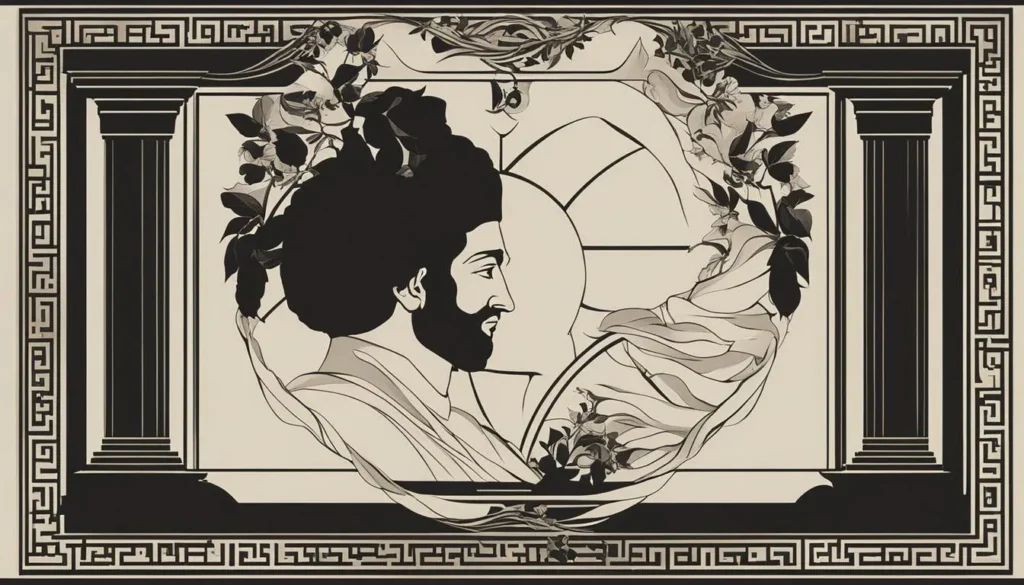A stoic meditation It is an ancient practice that aims to develop tranquility of the spirit and emotional balance. In this guide, we will explore the principles of stoicism and how to apply them in effective meditation. We will learn to bring these teachings to our current times and understand how they can positively impact our lives.

Main Conclusions:
- A stoic meditation It is an ancient practice that seeks to bring tranquility and emotional balance.
- The principles of stoicism They can be applied to meditation practice to obtain emotional and mental benefits.
- A stoic meditation can help with the development of emotional self-control and in the search for a more balanced life.
- Practicing Stoic meditation regularly can bring benefits such as emotional resilience and healthier relationships.
- O stoicism remains relevant in modern times and can help us cope with the stress and uncertainty of contemporary life.
Stoicism and Meditation
Stoicism is an ancient philosophy that offers valuable teachings for personal and emotional development. Within this philosophical context, Stoic meditation plays a fundamental role in the search for tranquility of the spirit and emotional balance. When practicing Stoic meditation, we are invited to reflect on the stoic virtues and stoic wisdom, applying them in our daily lives.
The Stoics believed that virtue is intrinsically linked to reason, and that the development of these virtues is essential to achieving a full and happy life. Stoic meditation provides us with tools to cultivate serenity, self-compassion, and acceptance of circumstances we cannot control. Through introspection and reflection, we can learn to deal with life's challenges in a more balanced and wise way.

Stoic meditation invites us to find a quiet place, close our eyes, and direct our attention to our breathing. It's a time to connect with ourselves, cultivate presence in the present moment, and reflect on Stoic principles. This practice helps us nourish our mind and spirit, strengthening our emotional resilience and developing a clearer and more objective view of life.
Stoicism and stoic meditation are powerful tools for facing the challenges of modern life. By applying Stoic principles to our personal journey, we can learn to accept adversity, cultivate self-reliance, and develop a more positive and resilient mindset. Stoic meditation invites us to delve within, explore our inner wisdom, and find the true meaning of life.

Benefits of Stoic Meditation:
- Increased mental and emotional tranquility
- Development of emotional resilience
- Improved ability to deal with stress and anxiety
- Hemp Cultivation healthy relationships
- Strengthening self-reliance and self-control
- Promoting acceptance and inner wisdom
Principles of Stoicism:
- Living according to nature and accepting what we cannot control
- Cultivate moral virtues, such as courage, wisdom and justice
- Stay focused on the present moment and what is within our control
- Letting go of negative emotions and cultivating self-compassion
- Seek self-development and constant improvement
| Principle | Overview |
|---|---|
| Living according to nature | It means accepting reality and focusing on what we can control, leaving aside unnecessary worries and frustrations. |
| Cultivate moral virtues | Develop characteristics such as courage, wisdom, justice and self-compassion, seeking to act in accordance with these virtues in all areas of life. |
| Stay focused on the present moment | Focus on the here and now, avoiding future worries and learning to fully appreciate the present moment. |
| Let go of negative emotions | Learn to deal with emotions in a balanced way, avoiding impulsive reactions and cultivating self-compassion and serenity. |
| Seek self-development | Continue learning and growing as an individual, always seeking self-development and constant improvement. |
Step by Step to Meditate
In this section, I will present a simple step-by-step guide for you to start your Stoic meditation practice. Remember that meditation can be done by anyone, even without prior experience.
- Find a quiet, comfortable place where you can focus without interruption. This can be in your home, in a park, or in any environment that provides peace and quiet.
- Close your eyes and start focusing on your breathing. Breathe deeply, paying attention to the sensations of air moving in and out of your body.
- Let go of future worries or negative thoughts. Focus only on the present and the sensations of the moment.
- As you meditate, observe your thoughts without judging them. Let them pass by like clouds in the sky, remaining emotionally detached.
- Reflect on the principles of stoic meditation. Visualize yourself facing challenges with serenity and wisdom, applying the stoic virtues in your daily life.
- When you finish the meditation, feel gratitude for the moments of peace and purpose that the practice brought to your day.
Over time, Stoic meditation will become a natural part of your routine, offering lasting benefits for your emotional balance and inner tranquility.

| Benefits of Stoic Meditation |
|---|
| Greater serenity and calm |
| development of emotional self-control |
| Greater resilience in the face of challenges |
| Better decision making |
| Strengthening moral virtues |
Now that you know Stoic meditation step by step, feel encouraged to start your practice and enjoy all the benefits it can bring to your life.
How Stoicism Can Help in Modern Life
Stoic philosophy is an ancient approach that offers valuable insights to face the challenges of modern life. By practicing Stoic meditation, we can develop emotional resilience, cultivate healthy relationships and apply practices that promote a full and meaningful life.
Emotional Resilience
One of the main advantages of stoicism is the ability to develop emotional resilience. By adopting a stoic mindset, we are encouraged to accept the circumstances we cannot control and focus on what is within our power. This perspective helps us face adversity with serenity, instead of letting ourselves be carried away by negative emotions. Stoic meditation helps us in this process, allowing us to practice emotional detachment and cultivate a more balanced mentality in the face of difficulties.
Healthy Relationships
Stoicism also teaches us about the importance of cultivating healthy relationships. When practicing Stoic meditation, we are invited to reflect on our interactions with others and adopt a stance of compassion, empathy, and acceptance. Through the practice of mindfulness and emotional self-sufficiency, we can develop more authentic and rewarding relationships, based on understanding and the pursuit of the common good.
Practices of Stoic Philosophy
Stoicism offers a variety of practices that we can incorporate into our daily lives. In addition to stoic meditation, we can adopt dichotomy of control, which encourages us to focus on what we can control, leaving aside what is beyond our power. We can also follow the path of virtue, seeking to develop moral virtues such as courage, wisdom and justice in our actions. By practicing these and other Stoic techniques, we become more resilient and capable of facing life's challenges with greater serenity and wisdom.

| Benefits of Stoicism in Modern Life | Practice Examples |
|---|---|
| Emotional resilience | Stoic meditation, practice of mindfulness |
| healthy relationships | Cultivate empathy, adopt compassion |
| emotional self-control | Practice self-sufficiency, use of dichotomy of control |
Guided Stoic Meditation
Try this guided meditation to find inner tranquility. Find a calm, comfortable place, close your eyes, and start paying attention to your breathing. Take a deep breath and visualize yourself placing problems in an imaginary box in front of you. Reflect on the impermanence of things and practice emotional detachment. Focus on the present and recognize your inner strength to face challenges wisely. End the meditation with gratitude and gratitude for the opportunity for growth.

Stoic meditation is a practice that allows us to cultivate serenity in the midst of life's challenges. Follow these steps for a guided meditation de stoic serenity:
- Find a quiet, comfortable spot where you can relax.
- Get into a comfortable position, sitting or lying down.
- Close your eyes and focus on your breathing.
- Breathe deeply, inhaling through your nose and releasing the air through your mouth.
- As you breathe, visualize yourself placing your problems in an imaginary box in front of you.
- Observe your thoughts and emotions calmly, letting them pass without getting caught up in them.
- Focus on the present moment and the feeling of calm that meditation brings.
- Recognize your inner strength and the ability to face challenges with wisdom and serenity.
- At the end of the meditation, feel gratitude for the opportunity for personal growth and development.
Practicing Stoic meditation regularly can help you find serenity amid chaos and develop a resilient mindset. Try this guided meditation and start harvesting benefits of stoic meditation in your life.
Developing Discipline Through the Key Principles of Stoicism
Stoicism is a philosophy that invites us to develop discipline and emotional self-control. Through key principles such as dichotomy of control: path of virtue, art of acceptance and mindfulness, we can cultivate a resilient mindset and face life's challenges with serenity.

The dichotomy of control is a principle that teaches us to focus on what is within our control and accept that which is beyond it. By understanding that we cannot control external events, we free ourselves from the stress and anxiety caused by situations that are beyond our control. We then focus on developing our character and moral virtues, following the path of virtue.
A art of acceptance invites us to embrace reality as it is, without resistance or frustration. We recognize that life is full of ups and downs, and that not everything is within our reach. By practicing acceptance, we become more flexible and adaptable, finding peace and contentment even in the face of adversity.
Mindfulness, in turn, helps us live the present moment with awareness and gratitude. By bringing our attention to the here and now, we connect with our inner strength and become more aware of the choices we make. Mindfulness allows us to act with wisdom and discernment, rather than reacting impulsively to circumstances.
Key Principles of Stoicism
| Principle | Overview |
|---|---|
| Dichotomy of Control | Focus on what is within our control and accept what is beyond it. |
| Path of Virtue | Cultivate moral virtues and develop a solid character. |
| Art of Acceptance | Accept reality as it is, without resistance or frustration. |
| Mindfulness | Live the present moment with awareness and gratitude. |
Through developing discipline and practicing the key principles of Stoicism, we can find greater inner peace and achieve a fuller, more meaningful life. Remember that the journey to discipline is not easy, but the fruits reaped are valuable. Stand firm in your commitment and allow stoicism to guide you in your quest for self-mastery and tranquility.

Classic and Current Philosophers of Stoicism
Stoicism, an ancient philosophy, was developed by classical philosophers who left a legacy of teachings on the practice of Stoicism. Additionally, there are contemporary philosophers who explore the application of this philosophy in modern life, making its teachings accessible and relevant to today's audiences.
Classical Philosophers of Stoicism
Among the classical philosophers of stoicism, Zeno of Citium, Epictetus, Seneca and Marcus Aurelius stand out. His works offer profound insights into how to apply Stoic principles to various aspects of life. Classical Stoicism teaches the importance of virtue, emotional discipline, and acceptance of reality.
Current Philosophers of Stoicism
In the current context, there are contemporary philosophers who explore Stoicism, adapting it for modern life. Among them are Ryan Holiday, author of books such as “The Obstacle is the Way”, Massimo Pigliucci, author of “How to Be a Stoic”, Donald Robertson, author of “Stoicism and the Art of Happiness”, William B. Irvine, author of “A Guide to the Good Life”, and Sharon Lebell, author of “The Art of Living: The Classical Manual on Virtue, Happiness, and Effectiveness”. These modern authors bring Stoicism into the present, offering practical guidance on how to apply Stoic principles in everyday situations.

| Classical Philosophers | Current Philosophers |
|---|---|
| Zeno of Citium | Ryan Holiday |
| Epithet | Massimo Pigliucci |
| Seneca | Donald Robertson |
| Marco Aurelio | William B. Irvine |
| Sharon Lebell |
These philosophers, both classic and current, contributed to the understanding and application of Stoicism, helping people to cultivate a resilient and balanced mindset when faced with life's challenges.
Conclusion
Stoic meditation is a powerful tool for personal development through reflection and practice. By incorporating the principles of stoicism into my daily life, I can find emotional balance and be more self-reliant.
Stoic meditation taught me to face adversity with wisdom and acceptance. Through reflection on Stoic teachings, I can cultivate a resilient mindset and seek inner serenity in difficult times.
As self-reliance practices, promoted by Stoic meditation, empower me to become a better person and find meaning in my personal journey. I am committed to continuing to apply these principles and stoic reflections in my life to achieve ever greater personal development.
FAQ
Q: What is Stoic meditation?
A: Stoic meditation is an ancient practice that seeks to develop tranquility of the spirit and emotional balance. It involves reflecting on Stoic principles and visualizing how to face challenges with serenity and wisdom.
Q: Who developed Stoicism?
A: Stoicism was developed by ancient Greek philosophers such as Zeno of Citius, Seneca, and Marcus Aurelius. They believed that virtues and reason were fundamental to a full and happy life.
Q: How to practice Stoic meditation?
A: Find a quiet, comfortable place, close your eyes and focus on your breathing. Practice deep breathing and reflect on Stoic principles. Visualize yourself facing challenges with serenity and wisdom. End the meditation with gratitude and purpose for your day.
Q: How can stoicism help in modern life?
A: Stoicism can help you deal with the stress, anxiety and uncertainty of modern life. By practicing Stoic meditation, we can develop a resilient mindset, face challenges with equanimity, and cultivate healthy relationships with ourselves and others.
Q: Is there a guided Stoic meditation?
A: Yes, you can try guided Stoic meditation to find inner tranquility. Close your eyes, focus on your breathing, and visualize yourself placing problems in an imaginary box in front of you. Practice emotional detachment and focus on the present, recognizing your inner strength to face challenges wisely.
Q: What are the key principles of Stoicism?
A: The key principles of Stoicism include the dichotomy of control, the path of virtue, the art of acceptance, and mindfulness. They help us focus on what we can control, cultivate moral virtues, accept reality, and develop emotional discipline.
Q: Who are some classic and current philosophers of Stoicism?
Some classical philosophers of stoicism are Zeno of Citium, Seneca, Epictetus and Marcus Aurelius. Additionally, there are contemporary philosophers such as Ryan Holiday, Massimo Pigliucci, Donald Robertson, William B. Irvine, and Sharon Lebell who explore the application of Stoicism to modern life.
Q: How can Stoic meditation help with personal development?
A: Stoic meditation can aid personal development by cultivating inner tranquility, emotional balance, and resilience. By reflecting on Stoic principles and practicing guided meditation, we can develop a calmer mindset and face life's challenges with wisdom and acceptance.
Source Links
- https://sabioestoico.com/guia-para-fazer-uma-meditacao-estoica/
- https://www.everand.com/book/405432850/Meditacao-Guia-Passo-A-Passo-Para-Iniciantes-Para-A-Atencao-Plena-E-Uma-Conexao-Mais-Profunda-Consigo-Mesmo
- https://newtonrocha.wordpress.com/2023/07/07/introducao-ao-estoicismo-e-guia-de-leitura-para-meditacoes-de-marco-aurelio-nitrodicas-de-filosofia-filosofia-estoicismo/







